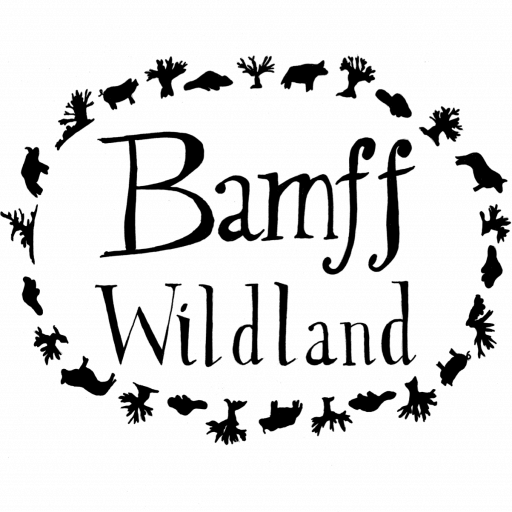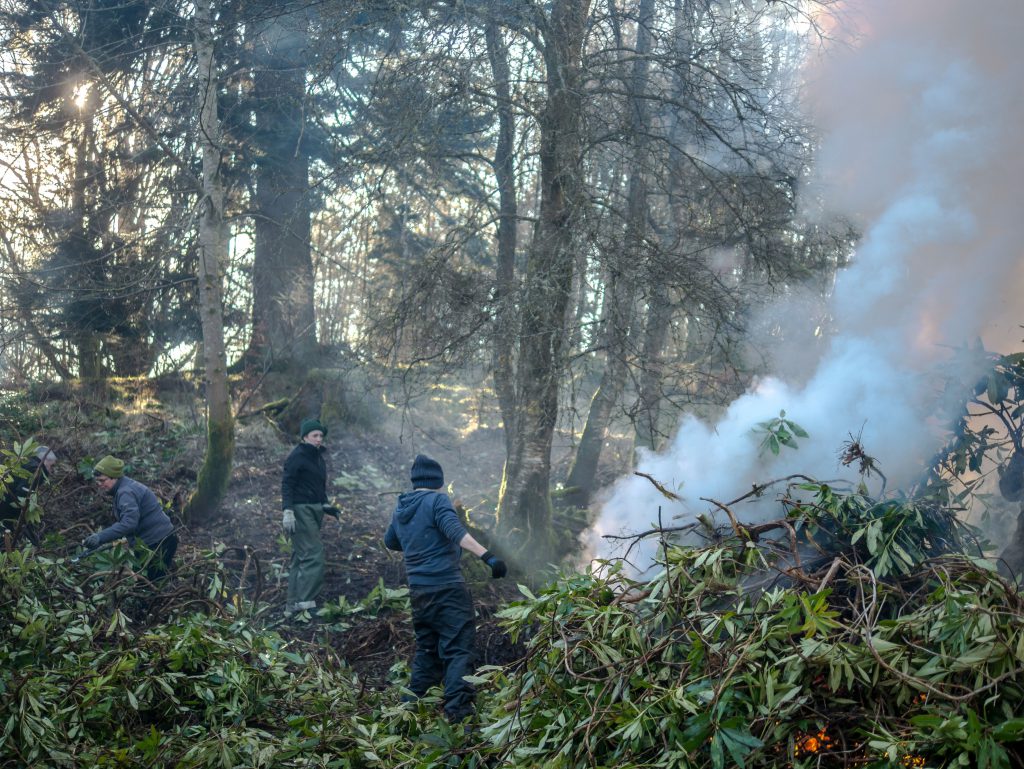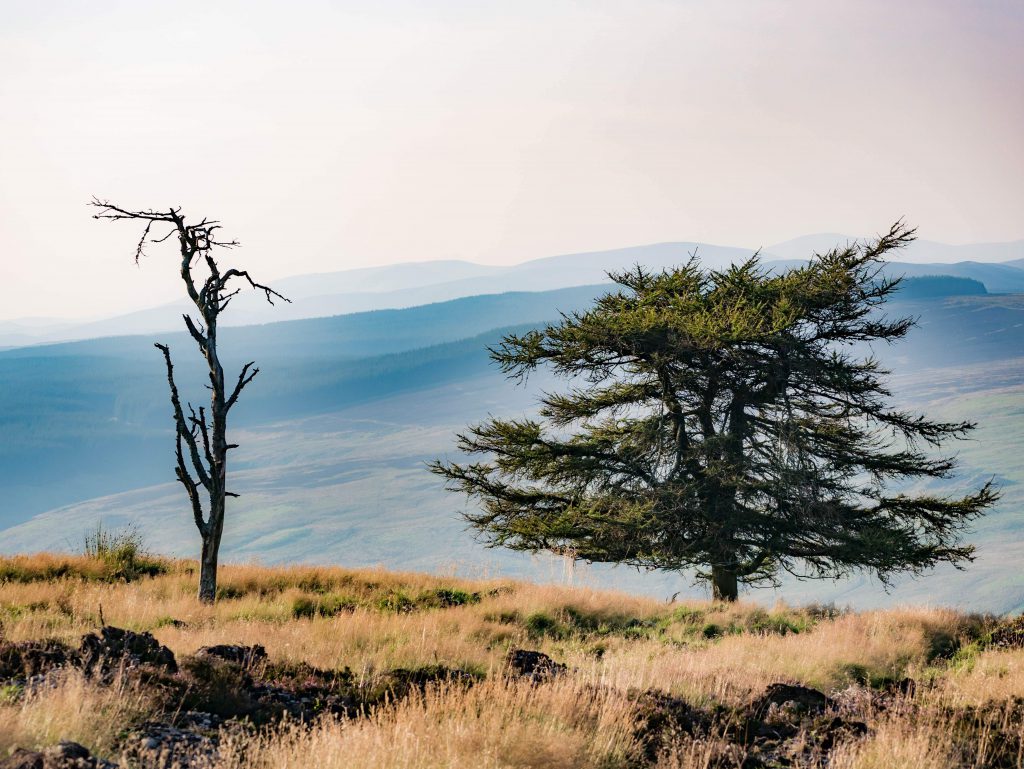Woodland
Trees at Bamff
Early History
Many centuries ago Bamff was largely wooded – in places where it was not too wet or open because of wind-blow, fire or grazing and browsing by wild herbivores. Willow and alder will have grown in the wet places; oak and ash, birch, hazel and rowan here and there, along with bird cherry, holly, gean and an understory of hawthorn and blackthorn, rose, bramble, raspberry and much more. In the uplands on more acid soils there would have been pine with juniper and heather, then blaeberry and cranberry on the forest edge and a forest floor carpeted with flowers in the spring.
Throughout the centuries much of the original woodland was cleared – and the land browsed and grazed by livestock.
Eighteenth Century
By the eighteenth century a new awareness of the beauty of landscape and a desire for more trees brought about the fashion for designed landscapes and at Bamff Thomas White, a pupil of Capability Brown, was engaged to design a new landscape with beech trees, planted artistically in roundels, copses and lines about the land. At this time ambitious drainage was also carried out. His plan was partially carried out and the trees planted in the 1780s are now mature and magnificent visual features of today’s Bamff.
No one thought about nativeness in the past and the exotic was often preferred over the native. Beech trees are native to the south of England and might have made their way to Scotland naturally eventually in any case. Although they offer habitat to many species they are not as rich in wildlife as Scottish native trees and the deep shade they cast generally prevents the growth of an understory of thorn bushes or flowers such as bluebells on the forest floor.
Nineteenth Century
By the 19th century our ancestors looked further afield for trees and plants in general. In fact in Victorian times plant hunting was a tremendous craze. Estates such as Bamff would compete to have the latest exotic tree and none more that the great firs and spruces from the lands being opened up in North America; the Noble Fir, the Douglas fir and even the now ubiquitous Sitka Spruce were all planted triumphantly as specimens trees in arboreta and to add interest to the landscape. By the 20th century many of these trees had reached magnificent heights standing high above the natives and now in the 21st century, although some have been blown over in gales, many still stand tall, visible from miles around.
Along with trees our Victorian and Edwardian ancestors also valued rhododendrons and azaleas. Exotic rhododendrons for the garden were often grafted on to the more invasive stock of rhododendron ponticum. Ponitcum was also planted as cover for pheasants for the ubiquitous pheasant shoot of the nineteenth and twentieth century estate. As it grows well and is difficult eradicate it is now classed as an invasive non native species and is difficult to get rid of. As it originates in Turkey almost no native species benefit from its presence, but if it is eliminated by persistent cutting – as it has been by volunteers in many parts of Bamff – foxgloves, raspberries and then birch and other trees quickly come in to replace it.
On the Bamff hill Scots Pine was planted in the nineteenth century, but most of it was felled again in the early twentieth century to pay death duties.
Twentieth Century to Present
The next stage of forestry was that of commercial plantations. These were trees planted not for beauty or for environmental value but for usefulness and to make money. The need for timber, exacerbated by the second world war, drove this industry which still persists today. The species chosen were more varied in earlier times and included European larch and Norway spruce, although usually planted in single species blocks and in straight lines. Later the industry settled on the American Sitka spruce as the tree of choice.
The mid twentieth century brought environmental awareness and the science of ecology. By the 1980s there were grants for the planting of native woodlands and later even for natural regeneration. At Bamff, woods complying with a range of different classifications as the various schemes came and went were planted to enrich the habitat. In the low ground farm woodland scheme woods were established and on the hill four native pine woods were planted.
Having inherited some commercial blocks from previous owners, various sections have matured and been thinned or clear-felled. One block was of Norway Spruce. This species is not actually considered native to the British Isles as it didn’t make it over the land bridge after the last ice age, but being a European species it is excellent habitat for other European species such as the red squirrel and the pine marten. This wood was therefore not clear felled altogether, but a large section of it was thinned instead and is now a delightful open wood with abundant regeneration occurring of birch, holly, rowan and some oak. It is also very popular with the red squirrels and the pine Martens that are sometimes seen there too.
The most recent woodland project at Bamff is the planting of the two Bamff hills of Balduff and Hilton. An area of 100 hectares has been fenced against incursions by sheep, cattle, roe deer, rabbits and hares and planted with a wide range of native species, including hazel, holly, native pine and oak
Until 2018 this area had been grazed by sheep for decades, if not centuries.
Although this looks a little artificial in its early years, with straight lines of scarification in the heather, it will eventually grow into a magnificent mixed native wood in the through thinning programmes that will gradually blur out the straight lines.
In late November 2021, Storm Arwen struck North-East Scotland with wind gusts of 120mph. The damage, to spruces especially, was extensive. They were unprepared for a powerful north wind, having spent their lives growing accustomed to the prevailing wind from the west.
The Tay Bridge wood was transformed overnight – root plates opening gaping holes in the earth. An eerie sight, but one that also revealed the inherent weakness of spruce plantations. Nevertheless, the natural thinning of these trees resulted in more light reaching the lower levels, which in turn results in a new opportunity for life to flourish.
Further storms arrived in the following months felling even more trees, again mostly spruces. Bamff’s landscape and habitat was changing whether we liked it or not.
We mostly did.







